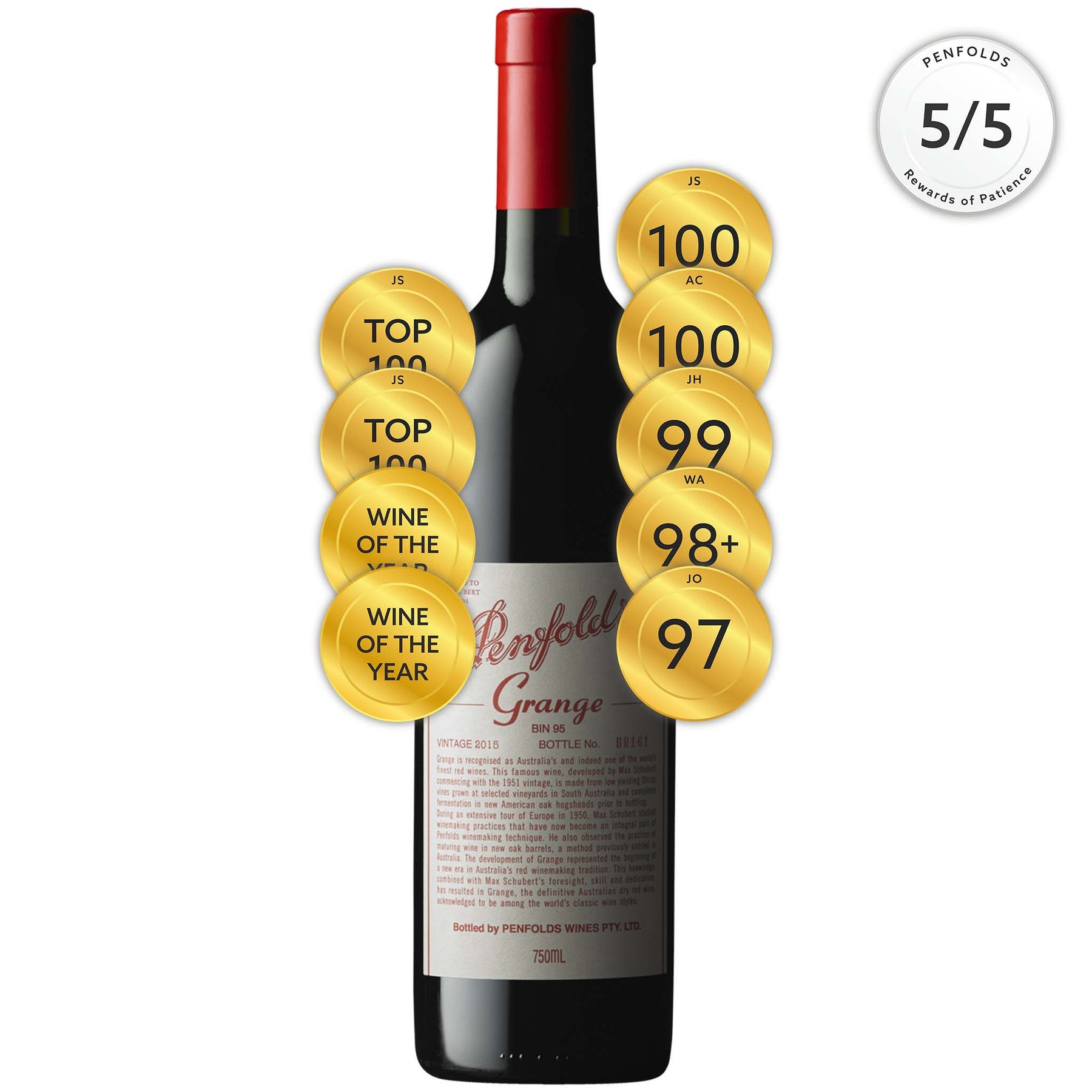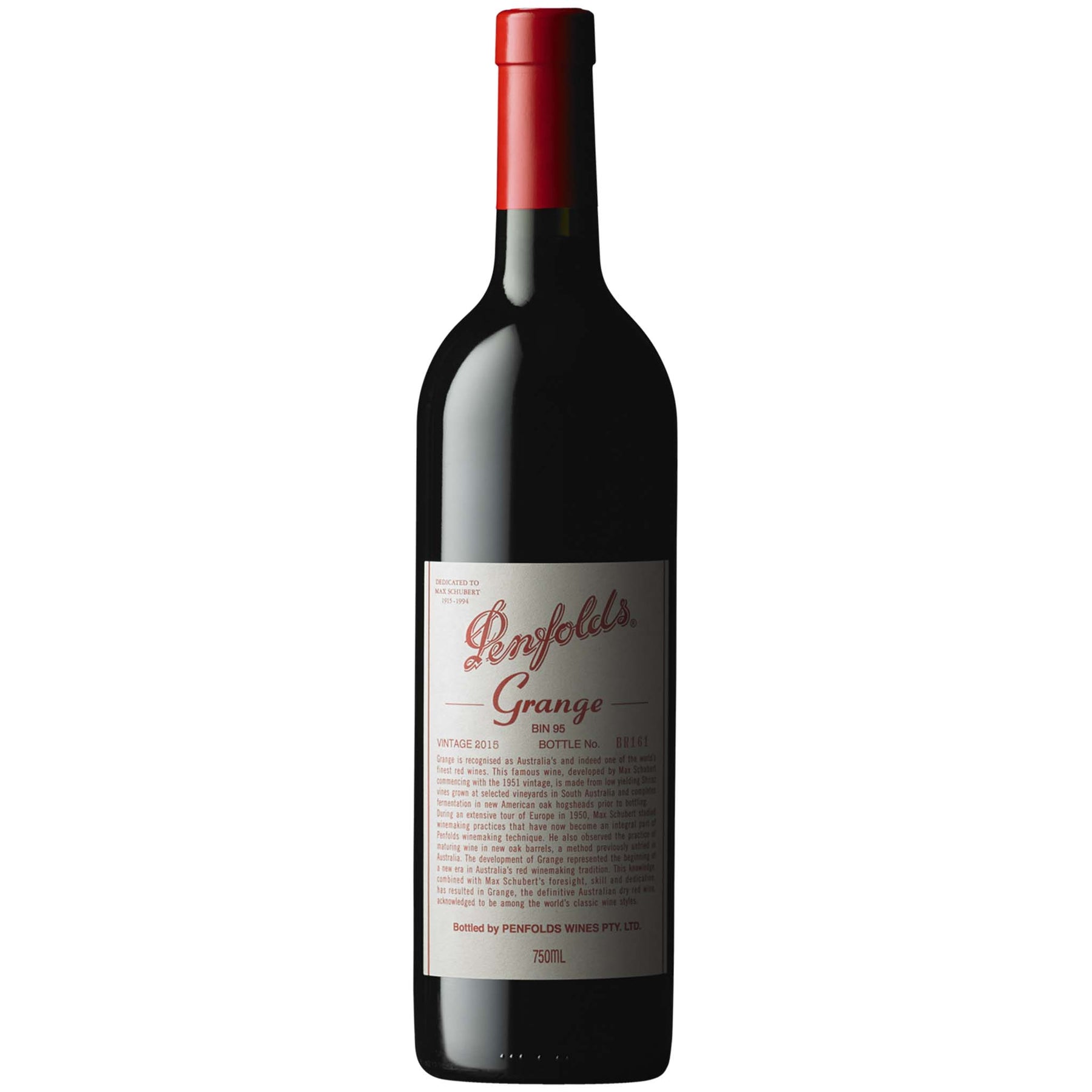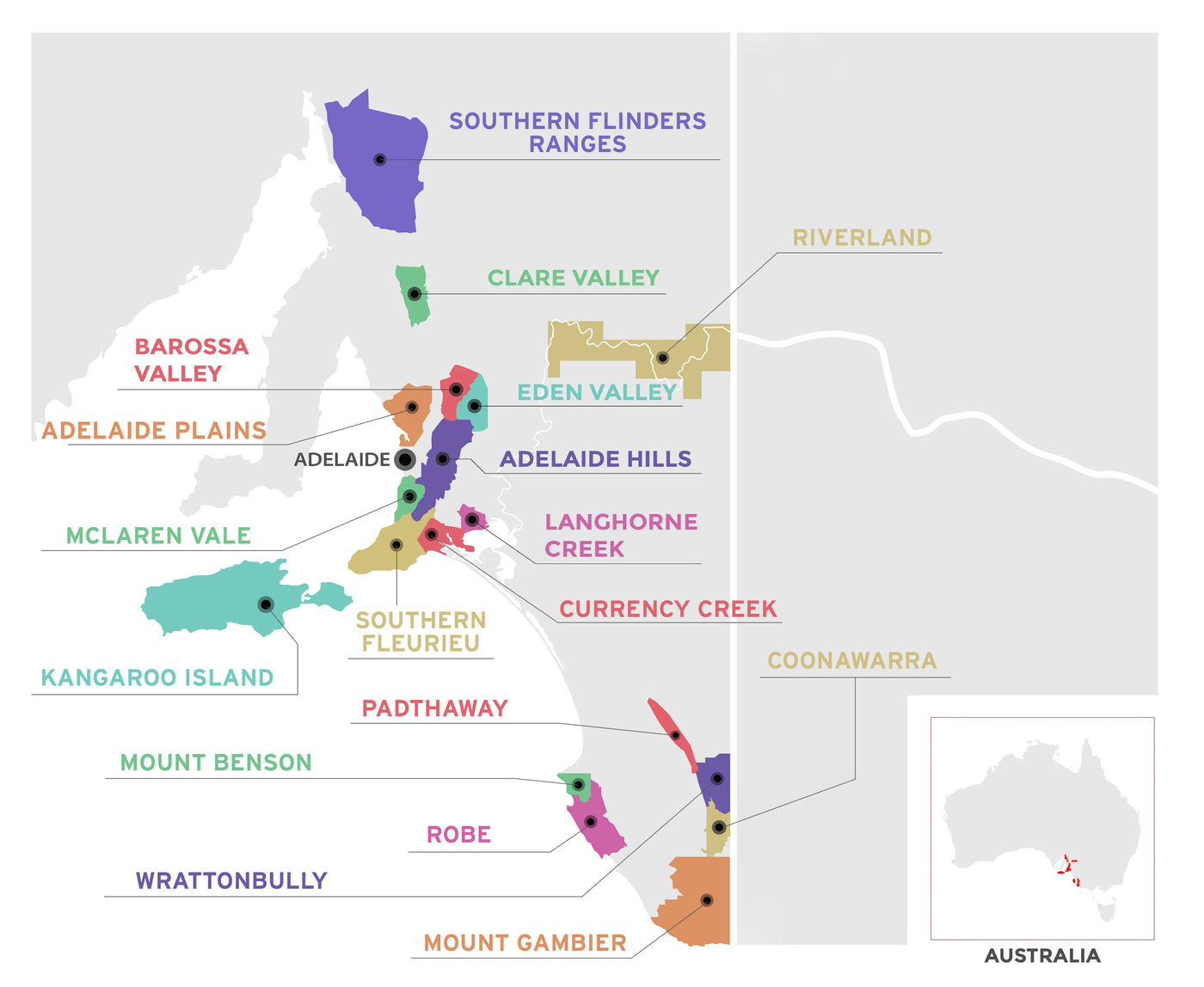

Penfolds Bin 95 Grange 2015
Style: Red Wine
Varieties: Shiraz (98%), Cabernet Sauvignon (2%)
Closure: Cork
Penfolds Bin 95 Grange 2015
Warehouse
34 Redland Drive
Vermont VIC 3133
Australia
Critic Score: 100
Alcohol: 14.5 %
Size: 750 ml
Drink by: 2065
Penfolds Rewards of Patience tasting panel 2021 - 5/5 rating
Robb Report Wine of the Year 2020
James Suckling Australian Wine of the Year 2019
James Suckling Top 100 Wines of the World 2019
James Suckling Top 100 Wines of Australia 2019
Penfolds Bin 95 Grange Shiraz is Australia's most famous wine with a reputation for superb fruit complexity and flavour richness. It is the most powerful expression of Penfolds multi-vineyard, multi-district blending philosophy and is officially listed as a Heritage Icon of South Australia. One of the world's great wines.
"A powerhouse of concentration and complexity. Such complexity. Classic Grange, offering such deep, dark intensity. The palate has immense richness and depth with a super succulent and very long, fleshy, deeply weighted array of dense, velvet-wrapped tannins that run so long. The finish is tightly wrenched, in spectacularly powerful style, locking this wine in for a very long haul." James Suckling
The 2015 Penfolds Grange is a blend of 98% shiraz and 2% cabernet sauvignon from premium vineyards in the Barossa Valley, McLaren Vale, Clare Valley and Magill Estate. The wine was matured for 20 months in American oak hogsheads (100% new).
"Deep crimson. Fresh blackberry, blackcurrant, red cherry, dark chocolate and mocha aromas with herb garden and star anise notes. Generous and supple with inky dark cherry, blackberry pastille and mulberry fruits, fine graphite textures, inky mid-palate complexity and fresh underlying mocha/crème brûlée oak. Silken, sinuous and beautifully integrated with extraordinarily restrained power and wonderful mineral length. Finishes with a firm chocolaty plume. Not as substantial as 2014 but more classic in structure like the Claret style first envisaged. Is it 1963 all over again? Drinking well, but will improve with time. Peak drinking 2030 to 2080.
Expert reviews
"Deep crimson. Fresh blackberry, blackcurrant, red cherry, dark chocolate and mocha aromas with herb garden and star anise notes. Generous and supple with inky dark cherry, blackberry pastille and mulberry fruits, fine graphite textures, inky mid-palate complexity and fresh underlying mocha/crème brûlée oak. Silken, sinuous and beautifully integrated with extraordinarily restrained power and wonderful mineral length. Finishes with a firm chocolaty plume. Not as substantial as 2014 but more classic in structure like the Claret style first envisaged. Is it 1963 all over again?" Penfolds Rewards of Patience tasting panel 2021 - 5/5 rating
"Much anticipated vintage for Grange and it is a powerhouse of concentration and complexity. Aromas of orange and lemon peel to start, then graphite, blackberries, plum paste, black cherries, boundless sweet oak spice, fresh cedar, tar, mahogany, roasted coffee and chocolate - the list goes on. Such complexity. Classic Grange, offering such deep, dark intensity. The palate has immense richness and depth with a super succulent and very long, fleshy, deeply weighted array of dense, velvet-wrapped tannins that run so long. The fruit flavors sit in the blackberry, blood-plum and blueberry zone with succulent, long and assertive structure, carrying through in an utterly seamless mode. The finish is tightly wrenched, in spectacularly powerful style, locking this wine in for a very long haul. Best from 2030." James Suckling, JamesSuckling.com – 100 points and Australian Wine of the Year 2019 and Top 100 Wines of the World 2019 and Top 100 Wines of Australia 2019
"Deep crimson. Intense blackberry, mulberry aromas with meaty roasted chestnut, vanilla malt notes. Classic Grange with inky blackberry mulberry fruits, dense chocolatey tannins, roasted chestnut, vanilla mocha oak complexity, a touch of crème brulée, superb mid palate richness, velvety tannins building to a firm chocolatey plume at the finish. All the elements are perfectly aligned. A Classic Great Grange with superb colour, density and tannin quality. A wonderful wine of huge presence and palate impact. Should outlive us all. A collector's vintage. Drink 2030-2060." Andrew Caillard MW – 100 points
"Australia had a hard year battling persistent and traumatic wildfires, so it's particularly gratifying to celebrate one of its natural, national treasures. With a taste of the Shiraz at Penfolds' recorking clinic in Los Angeles last fall, it was love at first sip. Actually, at first scent. Heady with aromas of forest floor, coffee, black licorice and an unusual explosion of violets, the wine was transfixing. And it tastes even better than it smells. The vibrant dark-berry and subtle spice notes seduce, penetrating through layers of minerals and acid, and there's impressive balance between the fruit and integrated, supple tannins. While Shiraz grapes are the star (at 98 percent), winemaker Peter Gago adds a splash of Cabernet Sauvignon from one of Penfolds' most precious plots, Block 42 of the Kalimna Vineyard, which nurtures what are thought to be the oldest continuously producing Cabernet vines in the world, planted in the 1880s. The 2015 harvest was warm and fast, resulting in beautiful fruit. Gago aged the wine for 20 months in new American oak hogshead barrels before bottling it for the cellars. The 2015 is delicious now - "At once lively and expressive, yet still not revealing all,” says Gago - but will be even more impressive in 10 years. It's a shining example of Grange." Wine of the Year - Robb Report
"Bang. The first whiff cries Grange. A lifted, fragrant, harmonious blend of fruit, oak (American, of course) and finely pitched tannins. Faultless. It's all relative, but this is starting to relax its grip. And the length is very, very special. Drink by 2055." James Halliday, Halliday Wine Companion - 99 points
"The nose of the 2015 Grange features the wine's characteristic lifted aromas, joined by pronounced American oak influence and bold blackberry fruit, plus hints of red meat, raspberries, asphalt and vanilla. It's dense and concentrated on the palate, full-bodied yet balanced and firm, with a rich, velvety texture and long, plush finish. Don't expect great complexity at this stage—it's much too young to show much more than the primary fruit and oak elements—but this is a Grange that should easily go three or four decades. Drink 2025-2050." Joe Czerwinski, Robert Parker's Wine Advocate – 98+ points
"This 2015 release of Penfolds Grange was sourced from a number of South Australian regions (Barossa Valley, McLaren Vale, Clare Valley and Magill Estate). It's made using 98% shiraz and 2% cabernet sauvignon. It saw, of course, 100% new American oak, for 20 months. 2015 wasn't a bad year, let's say, though what is in the glass is all that counts, even with Grange.
Don't mind if I do. There are clear notes of coconut here, indeed more than I can ever remember in a young Grange. That will ring alarm bells for some but, in my opinion, it can mention coconut all that it likes; it still manages to get away with it. The combination of richness, length, tannin spread and balance places this straight in the realms of the elite. Individual descriptors: who cares. It's deep, bold, muscular and dark, and it delivers all this in svelte, satiny, seductive fashion. This 2015 release of Grange is no disappointment. Indeed it's as good as you'd hope and/or expect. The finish: it soars. Tasted: Aug 19; Alcohol: 14.5%; Price: $900; Closure: Cork; Drink: 2026-2044+." Campbell Mattinson, The Wine Front - 97 points
"Lustrous and perfumed, with an arrestingly pure and heady bouquet of translucently clear dark plums, blackberries, cassis and dark cherries overlying notes of dark chocolates, bouquet of garni, roasting meats and cedar. It's both sumptuous and stylish; an artfully modern shiraz whose explosively flavoured, sour-edged fruit suggests the meaty, five spice and deeply layered qualities of old Puer tea. Extending with exceptional drive and shape over a firmish spine of fine, crunchy tannins, it's artfully balanced, wrapped in a lively acidity and set for the long haul. Reminiscent of the exceptional Granges from 1991 and 1994. Drink to 2045+." Jeremy Oliver - 97 points
"Distinctive and powerful, yet still elegant, showing restraint despite the dense and generous flavors. Precise notes of dark chocolate, maraschino cherry, mahogany and toasted coconut complement the core of wild blackberry and blueberry fruit. The tannins are smooth and polished, delivering some tug on the finish, which persists as subtle hints of dried lavender and white pepper linger. Drink now through 2040." MaryAnn Worobiec, Wine Spectator - 97 points
Awards
Wine of the Year 2020 - Robb Report
Australian Wine of the Year 2019 - James Suckling
Top 100 Wines of the World 2019 - James Suckling
Top 100 Wines of Australia 2019 - James Suckling
Penfolds Rewards of Patience tasting panel 2021 - 5/5 rating

South Australia
South Australian is responsible for more than half the production of all Australian wine. It is home to more than 900 wineries across 18 wine regions. The regions are Adelaide Hills, Adelaide Plains, Barossa Valley, Clare Valley, Coonawarra, Currency Creek, Eden Valley, Kangaroo Island, Langhorne Creek, McLaren Vale, Mount Benson, Mount Gambier, Padthaway, Riverland, Robe, Southern Fleurieu, Southern Flinders Ranges and Wrattonbully.
Many of the well-known names in the South Australian wine industry established their first vineyards in the late 1830s and early 1840s. The first vines in McLaren Vale were planted at Reynella in 1839 and Penfold's established Magill Estate on the outskirts of Adelaide in 1844.
South Australia has a vast diversity in geography and climate which allows the State to be able to produce a range of grape varieties - from cool climate Riesling in the Clare and Eden Vallies to the big, full bodied Shiraz wines of the Barossa Valley and McLaren Vale. Two of Australia's best-known wines, Penfolds Grange and Henschke Hill of Grace, are produced here. There is much to discover in South Australia for the wine lover.





